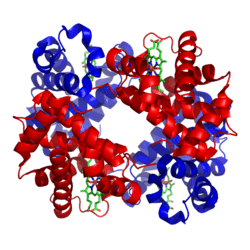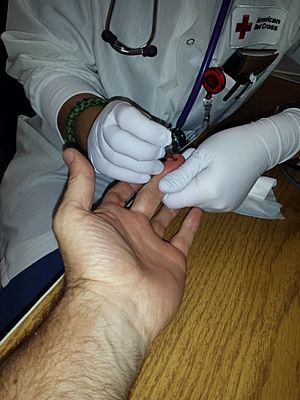Hemoglobin facts for kids

The α and β subunits are in red and blue.
The iron-containing heme groups in green
Hemoglobin is a protein found in red blood cells that is responsible for carrying oxygen throughout the body. It is composed of a protein called heme, which binds to oxygen. Hemoglobin levels are measured in a blood test and are expressed in grams per deciliter (g/dl). Normal levels of hemoglobin in the blood are 12 to 18 g/dl for males and 12 to 16 g/dl for females.
Low hemoglobin levels can be a sign of various health conditions, including anemia and cancer. Symptoms of low hemoglobin levels may include fatigue, weakness, and dizziness. The underlying cause of low hemoglobin levels can be diagnosed through medical tests, and treatment depends on the specific condition causing the decrease in hemoglobin
Contents
Structure
The most common type of hemoglobin in mammals contains four such subunits. Each subunit of hemoglobin is a globular protein (globin) with a heme group inside it. Each heme group has one iron atom. This binds one oxygen molecule. So the complete hemoglobin molecule has four globin chains, four heme molecules, and four iron atoms. When hemoglobin is in the lungs, it picks up oxygen in its hemes, and carries it to the rest of the body.
Its structure took years to work out. Max Perutz and John Kendrew worked out the structure of myoglobin first. That muscle globin is smaller, with only one heme group.
Diagnostic uses

Hemoglobin concentration measurement is among the most commonly performed blood tests, usually as part of a complete blood count. For example, it is typically tested before or after blood donation. Results are reported in g/L, g/dL or mol/L. 1 g/dL equals about 0.6206 mmol/L. Normal levels are:
- Men: 13.8 to 18.0 g/dL (138 to 180 g/L, or 8.56 to 11.17 mmol/L)
- Women: 12.1 to 15.1 g/dL (121 to 151 g/L, or 7.51 to 9.37 mmol/L)
- Children: 11 to 16 g/dL (110 to 160 g/L, or 6.83 to 9.93 mmol/L)
- Pregnant women: 11 to 14 g/dL (110 to 140 g/L, or 6.83 to 8.69 mmol/L) (9.5 to 15 usual value during pregnancy)
Images for kids
-
Max Perutz won the Nobel Prize for chemistry for his work determining the molecular structure of hemoglobin and myoglobin
-
A schematic visual model of oxygen-binding process, showing all four monomers and hemes, and protein chains only as diagrammatic coils, to facilitate visualization into the molecule. Oxygen is not shown in this model, but, for each of the iron atoms, it binds to the iron (red sphere) in the flat heme. For example, in the upper-left of the four hemes shown, oxygen binds at the left of the iron atom shown in the upper-left of diagram. This causes the iron atom to move backward into the heme that holds it (the iron moves upward as it binds oxygen, in this illustration), tugging the histidine residue (modeled as a red pentagon on the right of the iron) closer, as it does. This, in turn, pulls on the protein chain holding the histidine.
-
The giant tube worm Riftia pachyptila showing red hemoglobin-containing plumes
See also
 In Spanish: Hemoglobina para niños
In Spanish: Hemoglobina para niños





